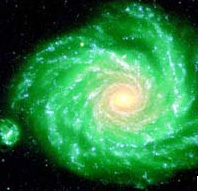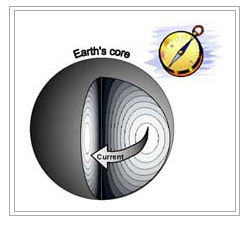Evidence for a Young World

Here are a dozen natural phenomena which conflict with the evolutionary idea that the universe is billions of years old. The numbers I list below in bold print (often millions of years) are maximum possible ages set by each process, not the actual ages. The numbers in italics are the ages required by evolutionary theory for each item. The point is that the maximum possible ages are always much less than the required evolutionary ages, while the Biblical age (6,000 to 10,000 years) always fits comfortably within the maximum possible ages. Thus the following items are evidence against the evolutionary time scale and for the Biblical time scale.
Much more young-world evidence exists, but I have chosen these items for brevity and simplicity. Some of the items on this list can be reconciled with an old universe only by making a series of improbable and unproven assumptions; others can fit in only with a young universe. The list starts with distant astronomic phenomena and works its way down to Earth, ending with everyday facts.
1. Galaxies wind themselves up too fast

The stars of our own galaxy, the Milky Way, rotate about the galactic center with different speeds, the inner ones rotating faster than the outer ones. The observed rotation speeds are so fast that if our galaxy were more than a few hundred million years old, it would be a featureless disc of stars instead of its present spiral shape.1
Yet our galaxy is supposed to be at least 10 billion years old. Evolutionists call this ‘the winding-up dilemma’, which they have known about for fifty years. They have devised many theories to try to explain it, each one failing after a brief period of popularity. The same ‘winding-up’ dilemma also applies to other galaxies.
For the last few decades the favored attempt to resolve the dilemma has been a complex theory called ‘density waves’.1 The theory has conceptual problems, has to be arbitrarily and very finely tuned, and lately has been called into serious question by the Hubble Space Telescope’s discovery of very detailed spiral structure in the central hub of the ‘Whirlpool’ galaxy, M51.2
2. Comets disintegrate too quickly
According to evolutionary theory, comets are supposed to be the same age as the solar system, about 5 billion years. Yet each time a comet orbits close to the sun, it loses so much of its material that it could not survive much longer than about 100,000 years. Many comets have typical ages of 10,000 years.3
Evolutionists explain this discrepancy by assuming that (a) comets come from an unobserved spherical ‘Oort cloud’ well beyond the orbit of Pluto, (b) improbable gravitational interactions with infrequently passing stars often knock comets into the solar system, and (c) other improbable interactions with planets slow down the incoming comets often enough to account for the hundreds of comets observed.4 So far, none of these assumptions has been substantiated either by observations or realistic calculations.
Lately, there has been much talk of the ‘Kuiper Belt’, a disc of supposed comet sources lying in the plane of the solar system just outside the orbit of Pluto. Even if some bodies of ice exist in that location, they would not really solve the evolutionists’ problem, since according to evolutionary theory the Kuiper Belt would quickly become exhausted if there were no Oort cloud to supply it. [For more information, see the detailed technical article Comets and the Age of the Solar System.]
3. Not enough mud on the sea floor

Each year, water and winds erode about 25 billion tons of dirt and rock from the continents and deposit it in the ocean.5 This material accumulates as loose sediment (i.e., mud) on the hard basaltic (lava-formed) rock of the ocean floor. The average depth of all the mud in the whole ocean, including the continental shelves, is less than 400 meters.6
The main way known to remove the mud from the ocean floor is by plate tectonic subduction. That is, sea floor slides slowly (a few cm/year) beneath the continents, taking some sediment with it. According to secular scientific literature, that process presently removes only 1 billion tons per year.6 As far as anyone knows, the other 24 billion tons per year simply accumulate. At that rate, erosion would deposit the present amount of sediment in less than 12 million years.
Yet according to evolutionary theory, erosion and plate subduction have been going on as long as the oceans have existed, an alleged 3 billion years. If that were so, the rates above imply that the oceans would be massively choked with mud dozens of kilometers deep. An alternative (creationist) explanation is that erosion from the waters of the Genesis flood running off the continents deposited the present amount of mud within a short time about 5000 years ago.
4. Not enough sodium in the sea

Every year, river7 and other sources9 dump over 450 million tons of sodium into the ocean. Only 27% of this sodium manages to get back out of the sea each year.8,9 As far as anyone knows, the remainder simply accumulates in the ocean. If the sea had no sodium to start with, it would have accumulated its present amount in less than 42 million years at today’s input and output rates.9 This is much less than the evolutionary age of the ocean, 3 billion years. The usual reply to this discrepancy is that past sodium inputs must have been less and outputs greater. However, calculations which are as generous as possible to evolutionary scenarios still give a maximum age of only 62 million years.9 Calculations10 for many other sea water elements give much younger ages for the ocean. [See also Salty seas: Evidence for a young Earth.]

5. The Earth’s magnetic field is decaying too fast
The total energy stored in the Earth’s magnetic field has steadily decreased by a factor of 2.7 over the past 1000 years.11 Evolutionary theories explaining this rapid decrease, as well as how the Earth could have maintained its magnetic field for billions of years, are very complex and inadequate.
A much better creationist theory exists. It is straightforward, based on sound physics, and explains many features of the field: its creation, rapid reversals during the Genesis flood, surface intensity decreases and increases until the time of Christ, and a steady decay since then.12 This theory matches paleomagnetic, historic, and present data.13 The main result is that the field’s total energy (not surface intensity) has always decayed at least as fast as now. At that rate the field could not be more than 10,000 years old.14 [See also The Earth’s magnetic field: Evidence that the Earth is young.]
6. Many strata are too tightly bent
In many mountainous areas, strata thousands of feet thick are bent and folded into hairpin shapes. The conventional geologic time scale says these formations were deeply buried and solidified for hundreds of millions of years before they were bent. Yet the folding occurred without cracking, with radii so small that the entire formation had to be still wet and unsolidified when the bending occurred. This implies that the folding occurred less than thousands of years after deposition.15
7. Injected sandstone shortens geologic ‘ages’
Strong geologic evidence16 exists that the Cambrian Sawatch sandstone—formed an alleged 500 million years ago—of the Ute Pass fault west of Colorado Springs was still unsolidified when it was extruded up to the surface during the uplift of the Rocky Mountains, allegedly 70 million years ago. It is very unlikely that the sandstone would not solidify during the supposed 430 million years it was underground. Instead, it is likely that the two geologic events were less than hundreds of years apart, thus greatly shortening the geologic time scale.

8. Fossil radioactivity shortens geologic ‘ages’ to a few years
Radiohalos are rings of color formed around microscopic bits of radioactive minerals in rock crystals. They are fossil evidence of radioactive decay.17 ‘Squashed’ Polonium-210 radiohalos indicate that Jurassic, Triassic, and Eocene formations in the Colorado plateau were deposited within months of one another, not hundreds of millions of years apart as required by the conventional time scale.18 ‘Orphan’ Polonium-218 radiohalos, having no evidence of their mother elements, imply either instant creation or drastic changes in radioactivity decay rates.19,20
9. Helium in the wrong places
All naturally-occurring families of radioactive elements generate helium as they decay. If such decay took place for billions of years, as alleged by evolutionists, much helium should have found its way into the Earth’s atmosphere. The rate of loss of helium from the atmosphere into space is calculable and small. Taking that loss into account, the atmosphere today has only 0.05% of the amount of helium it would have accumulated in 5 billion years.21 This means the atmosphere is much younger than the alleged evolutionary age. A study published in the Journal of Geophysical Research shows that helium produced by radioactive decay in deep, hot rocks has not had time to escape. Though the rocks are supposed to be over one billion years old, their large helium retention suggests an age of only thousands of years.22 [See also Blowing Old-Earth Belief Away: Helium gives evidence that the Earth is young.]
10. Not enough stone age skeletons
Evolutionary anthropologists say that the stone age lasted for at least 100,000 years, during which time the world population of Neanderthal and Cro-magnon men was roughly constant, between 1 and 10 million. All that time they were burying their dead with artefacts.23 By this scenario, they would have buried at least 4 billion bodies.24 If the evolutionary time scale is correct, buried bones should be able to last for much longer than 100,000 years, so many of the supposed 4 billion stone age skeletons should still be around (and certainly the buried artefacts). Yet only a few thousand have been found. This implies that the stone age was much shorter than evolutionists think, a few hundred years in many areas.
11. Agriculture is too recent

The usual evolutionary picture has men existing as hunters and gatherers for 100,000 years during the stone age before discovering agriculture less than 10,000 years ago.23 Yet the archaeological evidence shows that stone age men were as intelligent as we are. It is very improbable that none of the 4 billion people mentioned in item 10 should discover that plants grow from seeds. It is more likely that men were without agriculture less than a few hundred years after the flood, if at all.24
12. History is too short
According to evolutionists, stone age man existed for 100,000 years before beginning to make written records about 4000 to 5000 years ago. Prehistoric man built megalithic monuments, made beautiful cave paintings, and kept records of lunar phases.25 Why would he wait a thousand centuries before using the same skills to record history? The Biblical time scale is much more likely.24
References
- Scheffler, H. and H. Elsasser, Physics of the Galaxy and Interstellar Matter, Springer-Verlag, 1987, Berlin, pp. 352–353, 401–413. Return to text.
- D. Zaritsky et al., Nature, 22 July 1993. Sky & Telescope, December 1993, p. 10. Return to text.
- Steidl, P.F., Planets, comets, and asteroids, Design and Origins in Astronomy, pp. 73–106, G. Mulfinger, ed., Creation Research Society Books, 1983, 5093 Williamsport Dr., Norcross, GA 30092. Return to text.
- Whipple, F.L., Background of modern comet theory, Nature 263:15–19, 2 September 1976. Return to text.
- Gordeyev, V.V. et al., The average chemical composition of suspensions in the world’s rivers and the supply of sediments to the ocean by streams, Doklady Akademii Nauk SSSR 238:150, 1980. Return to text.
- Hay, W.W., et al., Mass/age distribution and composition of sediments on the ocean floor and the global rate of subduction, Journal of Geophysical Research 93(B12):14,933–14,940, 10 December 1988. Return to text.
- Maybeck, M., Concentrations des eaux fluviales en elements majeurs et apports en solution aux oceans, Revue de Geologie Dynamique et de Geographie Physique 21:215, 1979. Return to text.
- Sayles, F.L. and P.C. Mangelsdorf, Cation-exchange characteristics of Amazon River suspended sediment and its reaction with seawater, Geochimica et Cosmochimica Acta 41:767–779, 1979. Return to text.
- Austin, S.A. and D.R. Humphreys, The sea’s missing salt: a dilemma for evolutionists, Proceedings of the 2nd International Conference on Creationism, Vol. II, Creation Science Fellowship, 1991, icr.org/article/sea-missing-salt. Return to text.
- Austin, S.A., Evolution: The ocean says NO! ICR Impact No. 8, October 1973, Institute for Creation Research. Return to text.
- Merrill, R.T. and M. W. McElhinney, The Earth’s Magnetic Field, Academic Press, London, 1983, pp. 101–106. Return to text.
- Humphreys, D.R., Reversals of the earth’s magnetic field during the Genesis Flood, Proceedings of the 1st International Conference on Creationism, August 1986, Pittsburgh, Creation Science Fellowship, 1987, 362 Ashland Ave., Pittsburgh, PA 15228, Vol. II, pp. 113–126, creationicc.org/abstract.php?pk=22. Return to text.
- Coe, R.S., M. Prévot, and P. Camps, New evidence for extraordinarily rapid change of the geomagnetic field during a reversal, Nature 374:687–692, 20 April 1995. Return to text.
- Humphreys, D.R., Physical mechanism for reversals of the earth’s magnetic field during the Flood, Proceedings of the 2nd International Conference on Creationism, Vol. II, Creation Science Fellowship, 1991, icr.org/article/reversals-earths-magnetic-field-flood. Return to text.
- Austin, S.A. and J.D. Morris, Tight folds and clastic dikes as evidence for rapid deposition and deformation of two very thick stratigraphic sequences, Proceedings of the 1st International Conference on Creationism Vol. II, Creation Science Fellowship, 1986, pp.3–15, creationicc.org/abstract.php?pk=16. Return to text.
- ibid., pp. 11–12. Return to text.
- Gentry, R.V., Radioactive halos, Annual Review of Nuclear Science 23:347–362, 1973. Return to text.
- Gentry, R.V. et al., Radiohalos in coalified wood: new evidence relating to time of uranium introduction and coalification, Science 194:315–318, 15 October 1976. Return to text.
- Gentry, R. V., Radiohalos in a Radiochronological and cosmological perspective, Science 184:62–66, 5 April 1974. Return to text.
- Gentry, R. V., Creation’s Tiny Mystery, Earth Science Associates, 1986, P.O. Box 12067, Knoxville, TN 37912-0067, pp. 23–37, 51–59, 61–62. Return to text.
- Vardiman, L., The Age of the Earth’s Atmosphere: A Study of the Helium Flux through the Atmosphere, Institute for Creation Research, 1990, P.O.Box 2667, El Cajon, CA 92021. Return to text.
- Gentry, R. V. et al., Differential helium retention in zircons: implications for nuclear waste management, Geophysical Research Letters 9:1129–1130, October 1982. See also ref. 20, pp. 169–170. Return to text.
- Deevey, E.S., The human population, Scientific American 203:194–204, September 1960. Return to text.
- Marshak, A., Exploring the mind of Ice Age man, National Geographic 147:64–89, January 1975. Return to text.
- Dritt, J. O., Man’s earliest beginnings: discrepancies in the evolutionary timetable, Proceedings of the 2nd International Conference on Creationism, Vol. I., Creation Science Fellowship, 1990, pp. 73–78, creationicc.org. Return to text.
This article originally published by:
Dr Russell Humphreys
Creation Science Fellowship of New Mexico, Inc.
P.O. Box 10550
Albuquerque, NM 87184





Readers’ comments
Comments are automatically closed 14 days after publication.